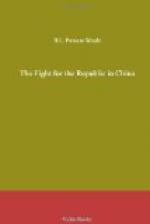The conviction expressed in the first portion of the Memorandum that bankruptcy was the rock on which the Peking administration must sooner or later split, and that the moment which Japan must seize is the outbreak of insurrections, is also highly instructive in view of what happened later. Still more subtle is the manner in which the ultimate solution is left open: it is consistently admitted throughout the mass of reasoning that there is no means of knowing whether suasion or force will ultimately be necessary. Force, however, always beckons to Japan because that is the simplest formula. And since Japan is the self-appointed defender of the dumb four hundred millions, her influence will be thrown on the side of the populace in order “to usher into China a new era of prosperity” so that China and Japan may in fact as well as in name be brought into the most intimate and vital relations with each other.
The object of the subsidized insurrections is also clearly stated; it is to alter China’s republican form of government into a Constitutional Monarchy which shall necessarily be identical in all its details to the Constitutional Monarchy of Japan and to no other. Who the new Emperor is to be is a point left in suspense, although we may here again recall that in 1912 in the midst of the revolution Japan privately sounded England regarding the advisability of lending the Manchus armed assistance, a proposal which was immediately vetoed. But there are other things: nothing is forgotten in the Memorandum. Russia is to be specially placated, England to be specially negotiated with, thus incidentally explaining Japan’s recent attitude regarding the Yangtsze Railways. Japan, released from her dependent foreign policy, that is from a policy which is bound by conventions and treaties which others respect, can then carry out her own plans without fear of molestation.
And this brings us to the two last documents of the dossier—the method of subsidizing and arranging insurrections in China when and wherever necessary.
The first document is a detailed agreement between the Revolutionary Party and various Japanese merchants. Trained leaders are to be used in the provinces South of the Yellow River, and the matter of result is so systematized that the agreement specifies the amount of compensation to be paid for every Japanese killed on active service; it declares that the Japanese will deliver arms and ammunition in the districts of Jihchow in Shantung and Haichow in Kiangsu; and it ends by stating that the first instalment of cash, Yen 400,000, had been paid over in accordance with the terms of the agreement. The second document is an additional loan agreement between the interested parties creating a special “trading” corporation, perhaps satirically named “The Europe and Asia Trading Company,” which in a consideration of a loan of half a million yen gives Japanese prior rights over all the mines of China.




